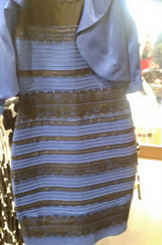AusSMC: The social media world has erupted into debate today over a visual conundrum – why is it that a  dress that looks gold and white to some people looks blue and black to others? See the dress here.
dress that looks gold and white to some people looks blue and black to others? See the dress here.
Below a vision scientist offers a scientific explanation.
Associate Professor Andrew Metha is in the Department of Optometry and Vision Sciences at the University of Melbourne. He comments:
“This is a great illusion, and I’m not surprised to learn it is going viral.
“I suspect that the in-office and over-dinner-table arguments taking place all over the world right now are caused by each of us making a different set of (internal, unconscious) assumptions about the visual scene we are shown.
“The first thing to assume is the nature of the illuminant under which the photograph was taken: was this in full sun, under clouds, or maybe indoors lit by incandescent lights? Each of these conditions have a very different spectral profile – that is, the amount of different wavelengths of light.
“This issue is something our brains have to deal with all the time as we move indoors and out through different environments. Vision scientists and psychologists have coined the phrase ‘colour constancy’ to describe the phenomenon by which an apple, for instance, retains its colour (perhaps red) under such widely different lighting conditions, even though the actual distribution of photon energies raining onto our retinas in each case can be very different.
“Exactly how we do this is still a matter that is hotly debated at vision science conferences, and all sorts of crazy and not-so-crazy schemes have been proposed as to how we “discount the illuminant’, even going back over 150 years to Helmholtz!
“The second assumption we make is the nature of the reflection from the material. Some materials, like satin or taffeta silk, are naturally very shiny and have what we call ‘specular’ or ‘glossy’ reflection properties – like light bouncing off a mirror. Other materials are diffusely reflective, like matt felt or t-shirt cotton. How we ultimately perceive the dress photo, particularly the darker parts (gold or black) will depend on what type of material we assume this part of the dress is made of.
“There is not enough information in the photo to be sure, and so we unconsciously decide this material has a reflection behaviour in one way or another, along a continuum from shiny to matt. The result of this unconscious assumption profoundly, and unexpectedly, affects how we ultimately interpret the colour of the dress.
“I’ve polled about 7 of my colleagues now – the blues are winning here. It is such an interesting phenomenon, and it’s got us who love thinking about colour vision all puzzled.
“And I am not certain the perceptual/psychological arguments given above are the whole story. In addition I wonder if there are some internal physiological differences going on amongst us, such as the relative proportion of L (long-wave sensitive, or red), M(middle-wave sensitive, green) and S (short-wave sensitive, cones) photoreceptor types in each of our eyes, that this is revealing? I am hedging for the former, but my mind remains open…”